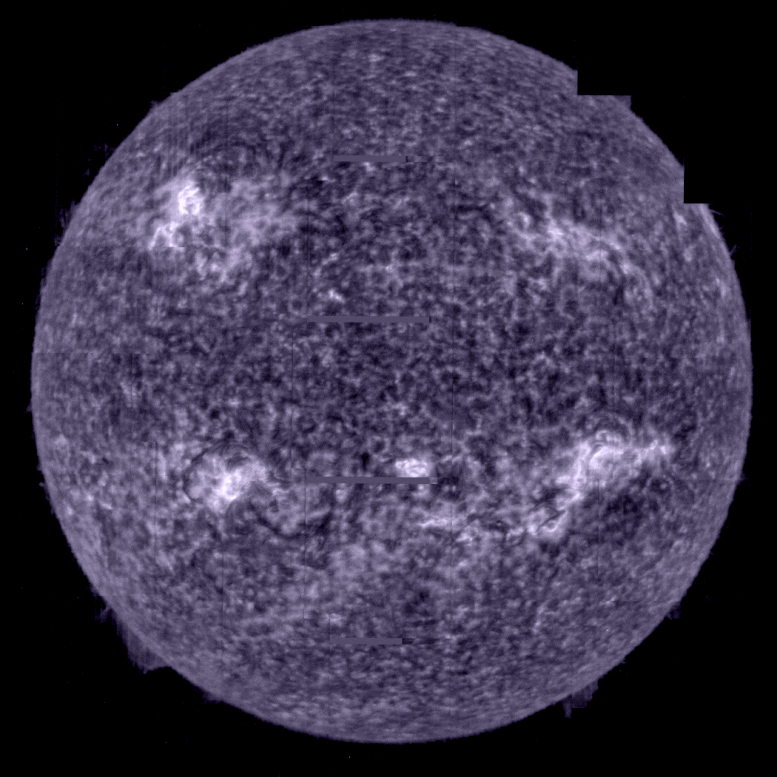
Animasi Solar Orbiter Badan Antariksa Eropa. Kredit: ESA / Medialab
Gambar Solar Orbiter terbaru menunjukkan matahari penuh dalam detail yang belum pernah terjadi sebelumnya. Itu diambil pada 7 Maret 2022, ketika pesawat ruang angkasa itu transit langsung antara Bumi dan Matahari.
Salah satu gambar yang diambil oleh Extreme Ultraviolet Imager (EUI) adalah gambar dengan resolusi tertinggi dari piringan matahari penuh dan atmosfer luar, korona, yang pernah diambil.
Gambar lain yang diambil oleh instrumen Spectral Imaging of the Coronal Environment (SPICE) mewakili gambar lengkap pertama Matahari dalam 50 tahun, dan gambar terbaik yang diambil sepanjang panjang gelombang beta Lyman dari radiasi ultraviolet yang dipancarkan oleh gas hidrogen.
Gambar-gambar itu diambil ketika pengorbit matahari berada sekitar 75 juta kilometer jauhnya, di tengah-tengah antara dunia kita dan bintang induknya. Teleskop resolusi tinggi EUI menangkap gambar dengan resolusi spasial yang tinggi sehingga, pada jarak sedekat itu, diperlukan sebuah mosaik 25 gambar individu untuk menutupi seluruh Matahari. Diambil satu per satu, gambar penuh diambil selama lebih dari empat jam karena setiap bagian membutuhkan waktu sekitar 10 menit, termasuk waktu yang dibutuhkan pesawat ruang angkasa untuk menunjuk dari satu bagian ke bagian berikutnya.

Matahari seperti yang terlihat oleh Solar Orbiter dalam sinar ultraviolet ekstrim dari jarak sekitar 75 juta km. Gambar tersebut adalah mosaik dari 25 gambar individu yang diambil pada 7 Maret 2022 oleh Teleskop Resolusi Tinggi Ultraviolet Imaging Instrument (EUI). Gambar ini diambil pada panjang gelombang 17 nanometer, di wilayah ultraviolet ekstrim dari spektrum elektromagnetik, mengungkapkan bagian atas atmosfer matahari, korona, yang memiliki suhu sekitar satu juta derajat Celcius. Gambar skala Bumi pada posisi jam 2. Kredit: ESA dan Tim NASA/Solar Orbiter/EUI; Pengolahan data: E. Kraaikamp (ROB)
Secara total, gambar akhir Ini berisi lebih dari 83 juta piksel dalam kotak 9148 x 9112 piksel. Sebagai perbandingan, gambar ini memiliki resolusi sepuluh kali lebih baik daripada yang dapat ditampilkan oleh layar TV 4K.
EUI menggambarkan Matahari pada panjang gelombang 17 nanometer, di wilayah ultraviolet ekstrim dari spektrum elektromagnetik. Ini mengungkapkan atmosfer atas matahari, korona, yang memiliki suhu sekitar satu juta derajat[{” attribute=””>Celsius.

Solar Orbiter took images of the Sun on March 7, from a distance of roughly 75 million kilometres, using its Spectral Imaging of the Coronal Environment (SPICE) instrument. SPICE takes simultaneous “spectral images” at several different wavelengths of the extreme ultraviolet spectrum by scanning its spectrometer slit across a region on the Sun. The different wavelengths recorded correspond to different layers in the Sun’s lower atmosphere. Purple corresponds to hydrogen gas at a temperature of 10,000°C, blue to carbon at 32,000°C, green to oxygen at 320,000°C, yellow to neon at 630,000°C. Each full-Sun image is made up of a mosaic of 25 individual scans. It represents the best full Sun image taken at the Lyman beta wavelength of ultraviolet light that is emitted by hydrogen gas. Credit: ESA & NASA/Solar Orbiter/SPICE team; Data processing: G. Pelouze (IAS)
At the 2 o’clock (near the image of the Earth for scale) and 8 o’clock positions on the edges of the Sun, dark filaments can be seen projecting away from the surface. These ‘prominences’ are prone to erupt, throwing huge quantities of coronal gas into space and creating ‘space weather’ storms.
In addition to EUI, the SPICE instrument was also recording data during the crossing. These too needed to be pieced together as a mosaic.
SPICE is designed to trace the layers in the Sun’s atmosphere from the corona, down to a layer known as the chromosphere, getting closer to the surface. The instrument does this by looking at the different wavelengths of extreme ultraviolet light that come from different atoms.

Taking the Sun’s temperature. Credit: ESA & NASA/Solar Orbiter/SPICE team; Data processing: G. Pelouze (IAS)
In the SPICE sequence of images purple corresponds to hydrogen gas at a temperature of 10,000°C, blue to carbon at 32,000°C, green to oxygen at 320,000°C, yellow to neon at 630,000°C.
This will allow solar physicists to trace the extraordinarily powerful eruptions that take place in the corona down through the lower atmospheric layers. It will also allow them to study one of the most puzzling observations about the Sun: how the temperature is rising through the ascending atmospheric layers.
Usually the temperature drops as you move away from a hot object. But above the Sun, the corona reaches a million degrees Celsius whereas the surface is only about 5000°C. Investigating this mystery is one of the key scientific objectives of Solar Orbiter.
The images were taken on 7 March, precisely when Solar Orbiter crossed the Sun-Earth line, so the images can be compared with Earth-bound solar instruments and cross-calibrated. This will make it easier to compare results from different instruments and observatories in future.
On March 26, Solar Orbiter reaches another mission milestone: its first close perihelion. The spacecraft is now inside the orbit of Mercury, the inner planet, taking the highest resolution images of the Sun it can take. It is also recording data on the solar wind of particles that flows outwards from the Sun.
And this is just the start, over the coming years the spacecraft will repeatedly fly this close to the Sun. It will also gradually raise its orientation to view the Sun’s previously unobserved polar regions.
Solar Orbiter is a space mission of international collaboration between ESA and NASA.

“Gamer yang sangat menawan. Ahli web. Sarjana TV. Pecandu makanan. Ninja media sosial yang rajin. Pelopor musik hardcore.”






More Stories
Sebuah studi baru menantang teori oksidasi mantel
Generasi Milenial dan Generasi X menghadapi risiko lebih tinggi terkena 17 jenis kanker ini dibandingkan generasi baby boomer: ScienceAlert
Sebuah pencapaian penting bagi NASA dalam menemukan exoplanet